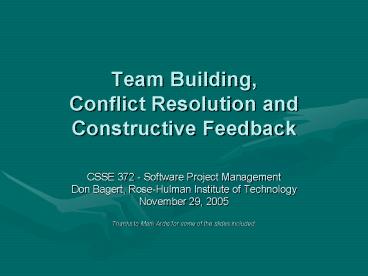Team Building, Conflict Resolution and Constructive Feedback - PowerPoint PPT Presentation
1 / 28
Title:
Team Building, Conflict Resolution and Constructive Feedback
Description:
Don Bagert, Rose-Hulman Institute of Technology. November 29, 2005 ... If something is bothering you, provide constructive feedback ASAP ... – PowerPoint PPT presentation
Number of Views:713
Avg rating:3.0/5.0
Title: Team Building, Conflict Resolution and Constructive Feedback
1
Team Building,Conflict Resolution
andConstructive Feedback
- CSSE 372 - Software Project Management
- Don Bagert, Rose-Hulman Institute of Technology
- November 29, 2005
- Thanks to Mark Ardis for some of the slides
included.
2
Team Building
3
Attributes of Productive Teams
- Shared, elevating vision
- Sense of team identity
- Results-driven structure
- Competent members
- Commitment to team
- Mutual trust
- Interdependence
- Effective communication
- Sense of autonomy
- Sense of empowerment
- Small team size
- High level of enjoyment
4
Shared, elevating vision
- Challenging work
- Important goal
5
Sense of team identity
- Something that makes the team different
- Example IBM Black Team
- Strive for and attain excellence
6
Results-Driven Structure
- Clear roles
- Effective communication
- Monitoring individual performance
- Decisions based on facts
7
Competent members
- Mix of skills, mix of roles
8
Commitment to team
- The needs of the many outweigh the needs of the
one. - Egoless Programming (Term coined by Gerald
Weinberg)
9
Mutual trust
- Honesty
- Openness
- Consistency
- Respect
10
Interdependence
- Relying on one another
- Asking for help
- Coming forward when necessary
11
Effective communication
- Team members express what they are truly feeling,
even when it is uncomfortable. - Bring things up early, when changes can be made
(more on this later)
12
Sense of autonomy
- No micromanagement
13
Sense of empowerment
- Ability to do whatever is necessary to succeed
- Story on page 287 about Windows 95
14
Small team size
- Less than 10
- More than 3
15
High level of enjoyment
- It's enjoyable to be productive
- Since it's enjoyable, people work more
- Sense of humor is important
16
Conflict Resolution
17
Acknowledgments
- Most of this material in this section is taken
fromhttp//www.colorado.edu/conflict/peace
18
Some Conflict Problems
- Framing
- Problems defining what the conflict is about and
how it is being addressed - Scoping
- Problems determining who is involved, what they
think, and the context or the environment of the
conflict - Communication
- Problems talking with and/or understanding people
involved in the conflict (on your side and on
other sides) - Procedural
- Problems with the formal (and informal) processes
which the parties use to interact with one
another - Escalation
- Problems involving the intensification of the
conflict
19
Examples of Treatment Strategies
- Framing what
- Win-win reframing
- Scoping who
- Analysis of similar conflicts
- Communication
- Active listening
- Procedural
- Consensus rule
- Escalation
- Cooling off periods
20
Dons Personal Viewson Conflict Resolution
- I feel a little uncomfortable about this topic
because I sometimes fail in conflict resolution - It is difficult to deal with a leader who tries
to control everything - Be honest at all times
- Be willing to admit youre wrong when appropriate
- Be willing to compromise
- Be open to mediation
21
Constructive Feedback
22
Acknowledgments
- Most of the material in this section is taken
fromhttp//lowery.tamu.edu/Teaming/morgan1.ppt
23
Constructive Feedback is
- Communication to a person (or group) regarding
the effect that a person's behavior has on
another person or on the group - Perceptions, feelings, and reactions to the
message
24
How to Give Constructive Feedback
Start with a When you . . . statement that
describes the behavior without judgment,
exaggeration, labeling, attribution, or motives.
Just state the facts as specifically as
possible. Tell how their behavior affects you.
If you need more than a word or two to describe
the feeling, its probably just some variation of
joy, sorrow, anger, or fear. Now say why you
are affected that way. Describe the connection
between the facts you observed and the feelings
they provoke in you.
- 1. When you . . .
- 2. I feel . . .
- 3. Because I . . .
From Scholtes, Peter R., The Team Handbook,
Joiner Associates (1988)
25
How to Give Constructive Feedback (cont.)
- 4. (Pause for Discussion)
- 5. I would like . . .
- 6. Because . . .
- 7. What do you think . . .
Let the other person respond. Describe the
change you want the other person to consider
... ... and why you think the change will
alleviate the problem. Listen to the other
persons response. Be prepared to discuss
options and reach consensus on a solution.
26
How to Give Constructive Feedback (Example)
- When you . . .
- I feel . . .
- Because I . . .
- (Pause for Discussion)
- I would like . . .
- Because . . .
When you are late for team meetings, I get
angry ... ... because I think it is wasting the
time of all the other team members and we are
never able to get through all of the agenda
items. ....... I would like you to
consider finding some way of planning your
schedule that lets you get to these team meetings
on time. Because that way we can be more
productive at the team meetings and we can all
keep to our tight schedules.
27
How Not to Give Constructive Feedback(Dons
views)
- Dont use abusive language
- Dont make it personal
- Dont speak in anger
- Dont wait too long (see next slide)
28
When to Give Constructive Feedback(Dons views)
- If something is bothering you, provide
constructive feedback ASAP - Feedback not given in a timely manner generally
leads to unconstructive feedback later!































